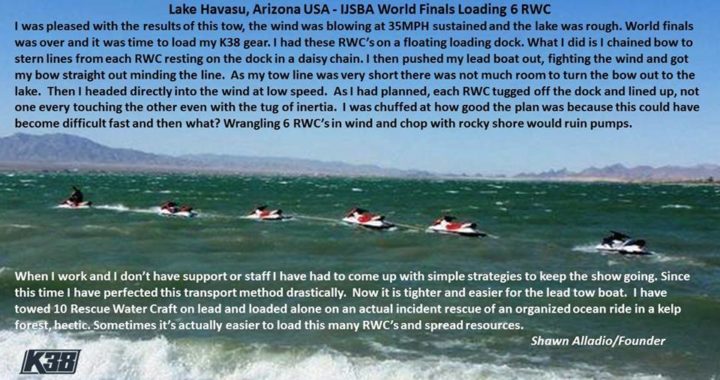Towing the Line.
Saving time, resources, logistics and manpower.
Anyhow, its much easier to tow a few of them than to have multiple operators at times.
We do this often in a few of our training grounds as well, because logistics can really impede on the clock!
Tension is your friend, not shockloading the tow line. This can be a bit of a struggle like in this photo with swell. Each craft will have a ‘step and pitch’ to its hull length and the oncoming water action and height.
It is important to have a solid understanding of the following:
1. Connector point hardware
2. Breaking strength of line
3. Towing speed (safe speed)
4. How its going to end
I oftentimes tow alone with four Jet Skis, as well as load them onto a single 4 place water vehicle trailer.
Taking my time and being methodical helps, but also thinking ahead, not where I am at presently or behind me where the craft are dragging. It’s important to be relaxed, calm and sure.
This can save time and resource management with low personnel available.
If by chance the towing vessel takes on debris into the water intake and a hand clearing of the water intake screen doesn’t solve the situation, its not too hard to switch out with another towing boat as long as its not sidelined as well.
Look down the line.
Observe your idle speed.
Observe the length of your tow string (boats).
Think about using a pivot point to slowly draw the craft towards you at a stopped position.
If trailering draw them towards the trailer bunks and let the forward section of the craft rest on them until its time to fully load and secure. One at at time…
If its a shoreline, secure a landing zone that has about 30′ feet for you to draw each bow up onto the shore.
Do not tug too hard on the lines, draw them slowly and steadily.
Practice! You may find this is a simpler solution for some situations you have to operate with.
Thanks for listening!
Shawn Alladio – 6.15.2018
Shawn cares most about her community and the culture surrounding the safety of event service providers and Rescue Water Craft operators, working hard and dedicated towards protecting their reputation, distributing safety information and continuing to train these amazing individuals to the highest standards of care.
